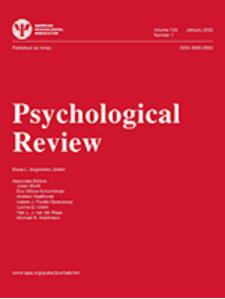Breaking the chains: Toward a neural-level account of episodic memory.
IF 5.8
1区 心理学
Q1 PSYCHOLOGY
引用次数: 0
Abstract
It has been suggested that episodic memory relies on the well-studied machinery of spatial memory. This influential notion faces hurdles that become evident with dynamically changing spatial scenes and an immobile agent. Here I propose a model of episodic memory that can accommodate such episodes via temporal indexing. Indices in the model have flexible duration, capable of exhibiting both fixed duration and broadening time fields akin to classical time cells. The latter cannot index episodes beyond short durations and are reminiscent of timing codes in scalar expectancy theory. Contrary to timing repetitive events, the present model focuses on the one-shot indexing of within-episode structure. Hippocampal indices are recruited by a combination of contextual inputs, lateral inhibition, and drive from temporal analogues of grid cells, functioning as an on-demand sequence generator and memory store. Indices learn connections to cortical representations, modulated by an amygdala signal. This architecture relies on biologically plausible, common network motifs, which can replay dynamically changing and spatially structured events, while an agent is immobile, suggests a mechanism for modulating the speed of recall, and can replay disjoint collections (i.e., broken chains) of indices with preserved temporal order. The model is embedded in an extensive review/perspective along two conceptual axes: first, how the model fits in with other accounts of time coding, serial order memory, and flexible temporal cognition and, second, how we can simultaneously reconcile the model framework with classical accounts of episodic memory à la Tulving, as well as with modern reinforcement learning and generative model accounts of hippocampal function. (PsycInfo Database Record (c) 2025 APA, all rights reserved).打破链条:对情景记忆的神经层面解释。
有人认为,情景记忆依赖于空间记忆机制的充分研究。这个有影响力的概念面临着一些障碍,这些障碍在动态变化的空间场景和不可移动的主体中变得明显。在这里,我提出了一个情景记忆模型,可以通过时间索引来适应这些情节。模型中的指数具有灵活的持续时间,既能表现出固定的持续时间,又能表现出与经典时间单元类似的扩展时间场。后者不能索引超过短持续时间的事件,并且使人想起标量期望理论中的时间代码。与对重复事件进行定时不同,该模型侧重于对情节内结构进行一次索引。海马体指数是由上下文输入、横向抑制和来自网格细胞的时间类似物的驱动组合而成的,其功能是按需序列发生器和记忆存储。指数学习与皮层表征的联系,由杏仁核信号调节。这种结构依赖于生物学上合理的、共同的网络基序,它可以重播动态变化和空间结构化的事件,而代理是不移动的,它提出了一种调节回忆速度的机制,并且可以重播具有保留时间顺序的不连接的索引集合(即断链)。该模型沿着两个概念轴嵌入了广泛的回顾/视角:首先,该模型如何与时间编码、序列顺序记忆和灵活的时间认知的其他描述相适应;其次,我们如何同时将模型框架与情景记忆的经典描述(la Tulving)以及现代强化学习和海马功能的生成模型描述相协调。(PsycInfo Database Record (c) 2025 APA,版权所有)。
本文章由计算机程序翻译,如有差异,请以英文原文为准。
求助全文
约1分钟内获得全文
求助全文
来源期刊

Psychological review
医学-心理学
CiteScore
9.70
自引率
5.60%
发文量
97
期刊介绍:
Psychological Review publishes articles that make important theoretical contributions to any area of scientific psychology, including systematic evaluation of alternative theories.
 求助内容:
求助内容: 应助结果提醒方式:
应助结果提醒方式:


